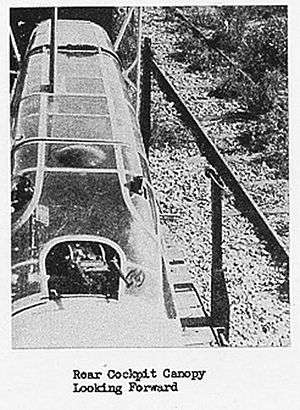MG FF cannon
| MG FF | |
|---|---|
 | |
| Type | Aircraft Cannon |
| Place of origin | Germany |
| Service history | |
| Wars | World War II |
| Production history | |
| Manufacturer | Ikaria |
| Specifications | |
| Weight | 26.3 kg (59.2 lbs.) |
| Length | 1.37 m (4 ft. 7 in.) |
|
| |
| Shell | 20×80mm |
| Caliber | 20 mm |
| Rate of fire | 520-540 rpm |
| Muzzle velocity | 585, 600 or 700 m/s |
The MG FF was a drum-fed, 20 mm aircraft autocannon, developed in 1936 by Ikaria Werke Berlin of Germany. It was a derivative of the Swiss Oerlikon FF F cannon, itself a development of the German World War I Becker 20 mm cannon, and was designed to be used in fixed or flexible mountings, as both an offensive and a defensive weapon. It saw widespread use in those roles by the German Luftwaffe, particularly during the early stages of World War II, although from 1941 onwards it was gradually replaced by the Mauser firm's 20 mm MG 151/20.
Compared to rival designs, such as the Hispano-Suiza HS.404 - which had been developed from the larger Oerlikon FF S - the MG FF had some disadvantages, such as low rate of fire and low muzzle velocity, as well as limited ammunition storage in its drums. On the other hand, it was much lighter and shorter. Wing installation on the Messerschmitt Bf 109 and Focke-Wulf Fw 190 fighters was not easy, as the drum required substantial space, and as a consequence the ammunition storage was initially reduced to 60 shells per drum. An ammunition drum of 90-round nominal capacity was developed for the Fw 190 A-5, and retrofitted to some earlier variants. There were also experiments with belt feedings.
The MG FF was adapted to fire a new type of high-capacity, high-explosive mine shell, called Minengeschoss that featured a projectile with thinner walls that allowed increased explosive charge. This projectile was lighter and generated less recoil than earlier projectiles requiring a modification of the recoil mechanism. With this modification it could fire the new mine shell, but accidentally using the heavier MG FF ammo could damage the gun. The now-called MG FF/M was introduced with the Bf 109 E-4 and Bf 110 C-4 in Summer 1940.
The MG FF and FF/M saw widespread use in fighters such as the Bf 109 E-3 to F-1, Bf 110 C to F, and Fw 190 A-1 to A-5. The Fw 190 was typically fitted with an inboard pair of MG 151 and an outboard pair of MG FF, although the MG FF were sometimes removed in the field in order to save weight. The cannon was also fitted to bombers such as the Do 217, Ju 88, He 111, Do 17, as well as many other aircraft. Although the MG FF was often replaced with the 20 mm MG 151/20 from 1941 onwards, it saw a come-back in 1943 as the primary Schräge Musik gun in the Bf 110 night fighters, as it fit perfectly into the rear cockpit.
The MG FF fired a 134 g projectile with a muzzle velocity of some 600 m/s and a rate of fire of about 520 rounds per minute. The MG FF/M fired a 90 g HE/M (high explosive mine shell) projectile with a muzzle velocity of c. 700 m/s and a rate of fire of c. 540 rounds per minute. AP, HE and incendiary projectiles were also available (115 to 117 g projectiles, 585 m/s, c. 520 rpm) because the mine-shot was not capable of holding incendiary or tracer parts.
Technical data

- Weight: 26.3 kg
- Length: 1.37 m
- Muzzle velocity:
- 600 m/s (MG FF),
- 585 m/s (MG FF/M with AP or HE),
- 700 m/s (MG FF/M with mine shell)
- Rate of fire:
- 520 rpm (MG FF, FF/M with AP or HE),
- 540 rounds per minute (MG FF/M with mine shell)
- Round types:
- armor-piercing (AP),
- high-explosive (HE), incendiary, all with or without tracer,
- high-explosive mine shell (HE(M)) (only MG FF/M)
See also
- List of firearms
- List of common World War II infantry weapons
- List of weapons of military aircraft of Germany during World War Two
Notes and references
External links
- Anthony G. Williams' "Cannon, Machine Guns and Ammunition"
- Emmanuel Gustin's WWII fighter gun performance tables